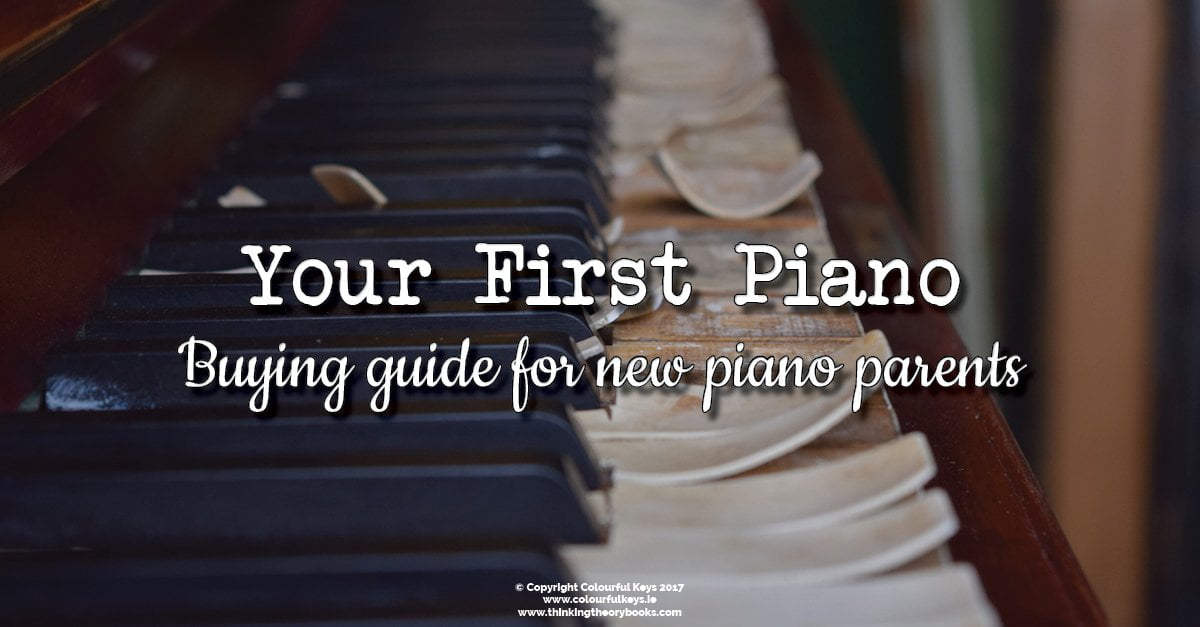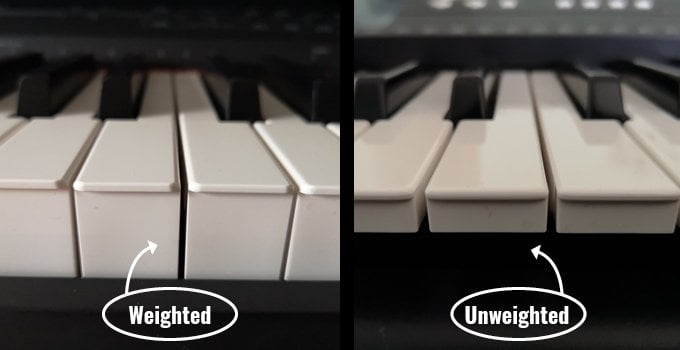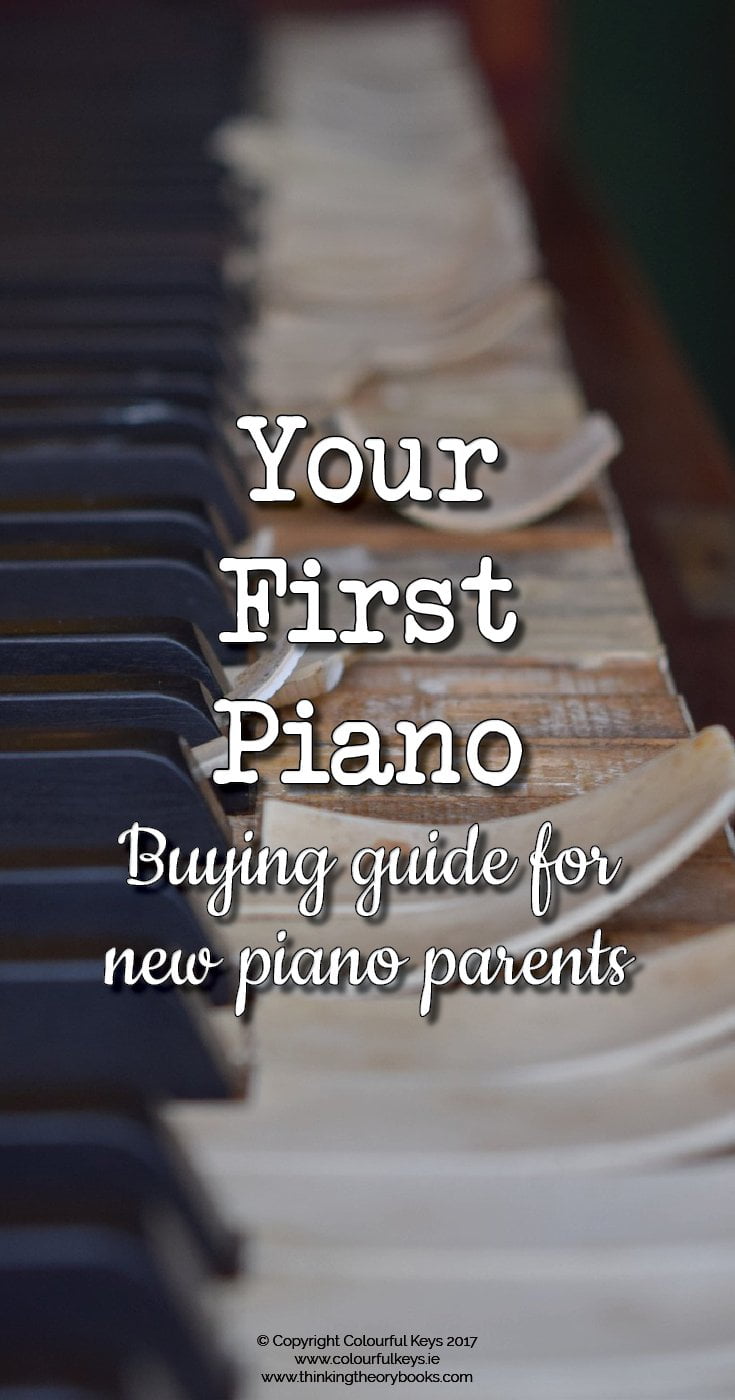Buying your first piano or keyboard? It can be a difficult choice, you don’t want something that you or your child are going to outgrow in a few months. But you might not want to invest too much is the beginning if you aren’t sure how long you or your child will stick with the piano.

In this post I will break down the options available to show you how to choose your first piano. Hopefully clearing up some of the terminology will help you make a more informed decision.
Watch the video above or read on for the written overview!
Upright Acoustic Pianos
A standard, traditional piano. Most have 88 keys, although I have come across some with less.

Pros:
- Best quality
- Long term reliable option
- Less shock when you need to play a piano in an exam or concert
- Authentic sound
Cons:
- Upkeep and ongoing costs – needs to be tuned every 1-2 years which should cost €80 – €200
- Difficult to move – if you are in rented accommodation or may be moving soon you need to think about moving costs, usually about €150 – €200
Price:
You can pick up a second-hand piano from about €150 upwards in auctions and on listing sites such as Adverts and DoneDeal. New pianos usually start at about €2000 but a well-maintained second-hand piano should be sufficient for most beginners.
Unweighted Keyboards
By unweighted we mean that the keys are light and easily depressed. You can normally tell if a keyboard is unweighted as it will have space under the keys rather than being solid.

I do not recommend an unweighted keyboard as a practice instrument.
“Touch sensitive” just means that if you press a key softly it plays a quiet note, and if you press it hard it will play a loud note. This is a step up from a toy keyboard but it will not allow students to develop the technique they need to be successful in their lessons.
It’s cheap, but it’s ultimately a false economy. You will not be making the most of your investment in piano lessons if your child has an unweighted keyboard
Pros:
- Cheap
- Lightweight
Cons:
- Will hold-back student’s technique development
- Is not satisfying to practice on
Price:
Second hand about €100 – €150, new about €200 – €400.
Weighted Keyboards and Digital Pianos
The next step up, for those who want the quality of a piano (almost!) but the flexibility and movability of a keyboard. Weighted keys are designed to feel like a piano, and require as much pressure to press the key down, simulating the hammer action in a traditional piano.

Pros:
- Adaptable
- Reasonably realistic piano sound
- Lightweight
- No tuning needed
Cons:
- Still not the full texture and rich sound of a piano
- Can be more expensive than second hand piano
Price:
Second hand about €300 – €600. New fully-weighted upwards of €1500. Semi-weighted upwards of €800.
Recommended Models
If you’re going to invest in a new digital piano I strongly recommend you get one with a “furniture stand” and pedal unit. This just means that it’s shaped sort of like an upright acoustic piano with pedals underneath and a solid base. (Although it’s still much narrower than an acoustic piano if space is a concern.)
- The Yamaha P-series are very reliable option and you can get a pack like this which includes the stand and pedals. I actually have an older version of this model in my studio which you can see a photo of above.
- Kawai ES120 is my current favourite. Make sure to get the option with the furniture stand, like this one.
- The Casio PX series are also very popular with piano teachers and students. Again, make sure you get a full stand set with pedals like this one.
Hybrid Pianos
Just like a hybrid car, a hybrid piano is designed to be the best of both worlds. They have real hammers inside and wooden keys just like an acoustic piano but they’re electric.
Pros:
- Can be used with headphones for silent practice
- Will connect to computers and iPads via midi cable
- Won’t need tuning
- Can imitate different types of pianos by switching modes
Cons:
- Expensive
Price:
Hybrid pianos start at about €2500 for the Casio Grand Hybrid, about €5000 for the Yamaha AvantGrand or about €6000 for the Kawai Novus, putting them out of the range of most beginner budgets. They are a great upgrade option to keep in mind if you start with a more basic keyboard and are well-worth the investment if you want to get the best long-term solution straight away.
The Often Overlooked Piano Bench
When you’re buying your child’s first piano or keyboard, don’t forget about the bench!
Many people think they can simply use a dining room chair. While that might be sort of OK for an adult, it’s far from an ideal for a child. You must have an adjustable bench that is designed for playing piano. This one from Thomann is perfectly adequate and very affordable.
If you’re buying a piano or keyboard from a store ask them if they will throw in an adjustable bench. If you need to source one yourself, I recommend these ones from Thomann as a simple and budget-friendly option.
The Right Piano or Keyboard for You
I hope this make some of the terminology in the different types of keyboards clear and helps you to make a decision on your first instrument.
Ultimately, you’ll need to balance budget with long-term value and other factors such as the space you have available. Make sure to talk to your teacher as well to see what they recommend. 🙂


Really great tips here, thank you!
Thanks for sharing this! I am trying to help my student find a new keyboard, and your post was perfect! 🙂
Would you recommend this brand and model? https://www.musicstore.com/en_IE/EUR/Fame-DP-4000-BK-Digital-Piano-Set-incl-Stand/art-EPI0000904-000
Personally, I wouldn’t recommend any specific models that I haven’t had a chance to play.
Thank you, Nicola! 🙂
Hey Nicola thanks. My 5-year old daughter is about to begin piano lessons and she got some vouchers as a birthday present. She has got very tiny hands and her fingers are not very strong at all, hence even though I would like to acquire a weighted keyboard I don’t think she would be able to play on this. Would you recommend any alternative? Is 5 year old too young to start “real” piano lessons? Thanks in advance!
Regardless of the child’s fingers I would not recommend an unweighted keyboard. 5 is not too young to start if the teacher knows what they’re doing. If they’re just teaching the same way they do for a 7-year-old that is not developmentally appropriate and thus you would be better with a general musicianship class.
Thanks! Clarified what I was thinking and clear enough for me to devise my own document with nzd costings.